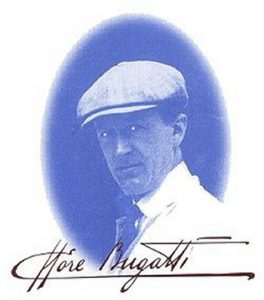Ettore Bugatti
 Ettore Bugatti (1881-1947) is perhaps most famous for his racing cars of the 20s and 30s which, as well as winning races, have been acknowledged as works of art. He was the son of Carlo, an acclaimed and successful designer of furniture, interiors, pottery and jewellery. Ettore’s brother Rembrandt became a sculptor, of international renown.
Ettore Bugatti (1881-1947) is perhaps most famous for his racing cars of the 20s and 30s which, as well as winning races, have been acknowledged as works of art. He was the son of Carlo, an acclaimed and successful designer of furniture, interiors, pottery and jewellery. Ettore’s brother Rembrandt became a sculptor, of international renown.
Having produced several car designs from 1899 for other companies, Ettore Bugatti set up a small factory in France in 1909. From there for more than 30 years he invented, designed and produced, with awesome variety, not only cars – which ranged from his innovative and successful tiny racing car in 1911 to the luxury limousines and grand touring cars of the 20s and 30s – but also engines, machine tools, railway rolling stock and many other examples of twentieth century industrial design.
Industrial Design and Invention
Ettore Bugatti was not formally trained in engineering but he developed a style and method of working seemingly based on his talents and self-confidence.
He suffered some spectacular failures but all his work is marked by an uncompromising design integrity allied to a simple and logical use of materials. He described his works as ‘thoroughbred’ (Pur Sang).
Please click on the links below for more information on the Bugatti family:
Carlo Bugatti (1856 – 1940) was born in Milan and became an artist and designer of international renown. He trained at the Brera Academy of Fine Arts and was greatly influenced by the early exponents of the ‘New Art’ in their reaction against the heavy, ornate, classical, Renaissance, Baroque and Rococo styles fashionable in the mid 19th Century.
Rembrandt Bugatti (1884 – 1916), younger son of Carlo, was a naturally gifted sculptor. As a child he was encouraged by the family friend and renowned sculptor, Paul Troubetzkoy, to work in plasticine or clay.
